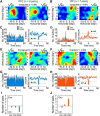Visual Receptive Field Heterogeneity and Functional Connectivity of Adjacent Neurons in Primate Frontoparietal Association Cortices
- PMID: 28821662
- PMCID: PMC6596803
- DOI: 10.1523/JNEUROSCI.0829-17.2017
Visual Receptive Field Heterogeneity and Functional Connectivity of Adjacent Neurons in Primate Frontoparietal Association Cortices
Abstract
The basic organization principles of the primary visual cortex (V1) are commonly assumed to also hold in the association cortex such that neurons within a cortical column share functional connectivity patterns and represent the same region of the visual field. We mapped the visual receptive fields (RFs) of neurons recorded at the same electrode in the ventral intraparietal area (VIP) and the lateral prefrontal cortex (PFC) of rhesus monkeys. We report that the spatial characteristics of visual RFs between adjacent neurons differed considerably, with increasing heterogeneity from VIP to PFC. In addition to RF incongruences, we found differential functional connectivity between putative inhibitory interneurons and pyramidal cells in PFC and VIP. These findings suggest that local RF topography vanishes with hierarchical distance from visual cortical input and argue for increasingly modified functional microcircuits in noncanonical association cortices that contrast V1.SIGNIFICANCE STATEMENT Our visual field is thought to be represented faithfully by the early visual brain areas; all the information from a certain region of the visual field is conveyed to neurons situated close together within a functionally defined cortical column. We examined this principle in the association areas, PFC, and ventral intraparietal area of rhesus monkeys and found that adjacent neurons represent markedly different areas of the visual field. This is the first demonstration of such noncanonical organization of these brain areas.
Keywords: functional connectivity; prefrontal cortex; single-unit recordings; ventral intraparietal.
Copyright © 2017 the authors 0270-6474/17/378919-10$15.00/0.
Figures







Similar articles
-
Comparison of visual receptive fields in the dorsolateral prefrontal cortex and ventral intraparietal area in macaques.Eur J Neurosci. 2017 Dec;46(11):2702-2712. doi: 10.1111/ejn.13740. Epub 2017 Nov 6. Eur J Neurosci. 2017. PMID: 29044804
-
Spatial Neuronal Integration Supports a Global Representation of Visual Numerosity in Primate Association Cortices.J Cogn Neurosci. 2020 Jun;32(6):1184-1197. doi: 10.1162/jocn_a_01548. Epub 2020 Feb 19. J Cogn Neurosci. 2020. PMID: 32073351
-
The cortical connections of area V6: an occipito-parietal network processing visual information.Eur J Neurosci. 2001 Apr;13(8):1572-88. doi: 10.1046/j.0953-816x.2001.01538.x. Eur J Neurosci. 2001. PMID: 11328351
-
Selective visual attention and perceptual coherence.Trends Cogn Sci. 2006 Jan;10(1):38-45. doi: 10.1016/j.tics.2005.11.008. Epub 2005 Nov 28. Trends Cogn Sci. 2006. PMID: 16318922 Review.
-
Anatomical origins of the classical receptive field and modulatory surround field of single neurons in macaque visual cortical area V1.Prog Brain Res. 2002;136:373-88. doi: 10.1016/s0079-6123(02)36031-x. Prog Brain Res. 2002. PMID: 12143395 Review.
Cited by
-
A concentration of visual cortex-like neurons in prefrontal cortex.Nat Commun. 2024 Aug 14;15(1):7002. doi: 10.1038/s41467-024-51441-3. Nat Commun. 2024. PMID: 39143147 Free PMC article.
-
Tracking neural activity from the same cells during the entire adult life of mice.Nat Neurosci. 2023 Apr;26(4):696-710. doi: 10.1038/s41593-023-01267-x. Epub 2023 Feb 20. Nat Neurosci. 2023. PMID: 36804648
-
Cell-type specific pallial circuits shape categorical tuning responses in the crow telencephalon.Commun Biol. 2022 Mar 25;5(1):269. doi: 10.1038/s42003-022-03208-z. Commun Biol. 2022. PMID: 35338240 Free PMC article.
-
Points and lines inside human brains.Cogn Neurodyn. 2019 Oct;13(5):417-428. doi: 10.1007/s11571-019-09539-8. Epub 2019 May 7. Cogn Neurodyn. 2019. PMID: 31565087 Free PMC article. Review.
References
-
- Aertsen AM, Gerstein GL, Habib MK, Palm G (1989) Dynamics of neuronal firing correlation: modulation of “effective connectivity.” J Neurophysiol 61:900–917. - PubMed
-
- Colby CL, Duhamel JR, Goldberg ME (1993) Ventral intraparietal area of the macaque: anatomic location and visual response properties. J Neurophysiol 69:902–914. - PubMed
Publication types
MeSH terms
LinkOut - more resources
Full Text Sources
Other Literature Sources
Miscellaneous
